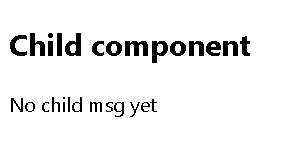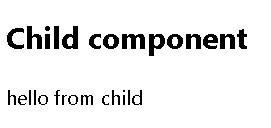除了接收 props,子組件還可以向父組件觸發事件:
<script setup>
// 聲明觸發的事件
const emit = defineEmits(['response'])
// 帶參數觸發
emit('response', 'hello from child')
</script>
emit() 的第一個參數是事件的名稱。其他所有參數都將傳遞給事件監聽器。
父組件可以使用 v-on 監聽子組件觸發的事件
<ChildComp @response="(msg) => childMsg = msg" />
<script setup>
import { ref } from 'vue'
import ChildComp from './ChildComp.vue'
const childMsg = ref('No child msg yet')
</script>
<template>
<ChildComp />
<p>{{ childMsg }}</p>
</template>

<script setup>
import { ref } from 'vue'
import ChildComp from './ChildComp.vue'
const childMsg = ref('No child msg yet')
const emit = defineEmits(['response'])
emit('response','hello from child')
</script>
<template>
<ChildComp @response="(msg) => childMsg = msg"/>
<p>{{ childMsg }}</p>
</template>

除了通過 props 傳遞數據外,父組件還可以通過插槽 (slots) 將模板片段傳遞給子組件:
<ChildComp>
This is some slot content!
</ChildComp>
在子組件中,可以使用 slot 元素作為插槽出口 (slot outlet) 渲染父組件中的插槽內容 (slot content):
slot插口中的內容將被當作“默認”內容:它會在父組件沒有傳遞任何插槽內容時顯示:
<slot>Fallback content</slot>
利用父組件的 msg 狀態為子組件提供一些插槽內容吧。
<script setup>
import { ref } from 'vue'
import ChildComp from './ChildComp.vue'
const msg = ref('from parent')
</script>
<template>
<ChildComp></ChildComp>
</template>

<script setup>
import { ref } from 'vue'
import ChildComp from './ChildComp.vue'
const msg = ref('from parent')
</script>
<template>
<ChildComp>Message: {{ msg }}</ChildComp>
</template>

